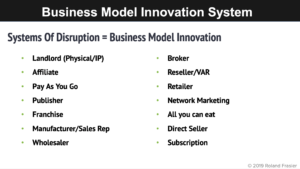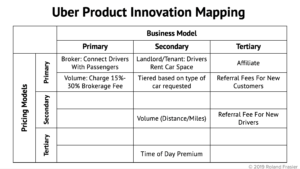One of the most overused terms across all industries is being a “disruptor.” So many already successful companies continually set their sights on this:
- “How can we disrupt the market?”
- “We need a disruptive idea to really put us back on coarse this year.”
The reason it’s so prevalent in the business today is because the uber successful companies (pun intended) transformed an already mature market and profited in such a way they’ve become the model home of the landscape we’re in.
At my most recent War Room Intensive, “Leverage, Grow, Buy & Sell,” we discussed just how brands like Uber & Airbnb did just that and how you can do it too. We’ve shared the full session on this in the video above.
(NOTE: need some insight or even just interested in attending Roland’s Leverage, Exit, Growth, & Scale Intensive? When they aren’t 100% filled with War Room members, we sometimes offer them to qualified business owners. In fact, we have a handful of seats left for the next two coming up.)
Regardless of the “disruptive” principals Uber established, it still falls under one of the 14 business models every business I’ve come across does.

You wouldn’t think that “Landlord/Tenant” applies to Uber, but it does. The landlord owns the car in this example, and the tenant is both Uber (for putting the passenger there) and the passenger.
What’s interesting is when you start mixing and matching these business models with different pricing models, you can get really creative. Here’s how Uber did it:

There’s about 14 basic pricing models to use. Uber’s primary business model was “Broker: Connect Drivers with Passengers” and their primary pricing model is “Volume.” Uber charges a 15-30% broker fee for connecting drivers with passengers.
As for the secondary models, Uber’s business model here is “Landlord/Tenant: Drivers Rent Car Space” and “Tiered Based on the Type of Car Requested.” Connect that with Uber’s secondary pricing model, “Volume: Distance & Miles.” and “Time of Day Premium (surge fees. Everyone’s favorite.)
Uber’s third model was rolled out when they created an Affiliate Program to pay out Referral Fees to New Customers,” and did the same for new drivers.
While it sounds like Uber was disruptive, they simply did something unique in a mature market. You can take these business & pricing models and mix & match them for your business, the same as Uber did to become so “disruptive.”
(NOTE: the full clip in the video above also details how Airbnb did this too and even more insight into how you can effectively disrupt like these two companies did in their industries.)
If you thought this was interesting, we have MUCH more for you…
Interested in War Room? See if you qualify below.